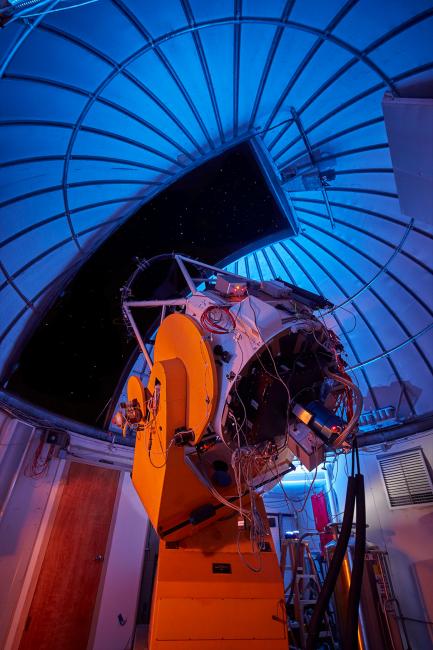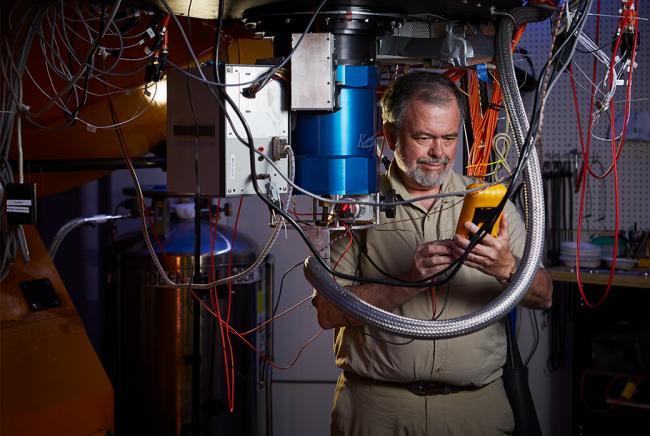1.2 Meter (48-inch) Telescope
The 1.2-Meter (48 Inch) Telescope is a general purpose visible-light telescope located at the Fred Lawrence Whipple Observatory (FLWO), a major observational facility of the Center for Astrophysics | Harvard & Smithsonian located in southern Arizona. Astronomers use this telescope to observe objects in the Solar System and the Milky Way, as well as other galaxies, including the supermassive black holes known as quasars. Astronomers also use the 1.2-Meter Telescope to observe star systems that might contain exoplanets, which is a major program for the observatory.

The Telescope and the Science
The FLWO 1.2-Meter Telescope is an optical telescope designed to produce images of a wide variety of astronomical objects. The telescope is used to study the rise and the fade of light from supernova explosions, observe the bright supermassive black holes known as quasars, and study promising star systems for exoplanet searches. The system is robotic, meaning it can be controlled by automatic computer commands, in addition to control by a human operator, either remotely or on-site.
The camera on the 1.2-Meter is KeplerCam, which was designed and built by researchers at the Center for Astrophysics | Harvard & Smithsonian. As the name indicates, its original purpose was to provide support for NASA’s Kepler Telescope, a very successful orbiting observatory dedicated to the search for exoplanets. KeplerCam is composed of charge-coupled devices (CCDs), based on the same technology as digital cameras, and takes images 4096x4096 pixels in size. Astronomers used the 1.2-Meter telescope with the KeplerCam CCD to identify stars of interest for Kepler observation, and continue to use it to follow up on exoplanet candidates.
Additionally, KeplerCam supports many other CfA projects, including observations of supernova that provide a measurement of the expansion rate of the universe. Type Ia supernovas are the explosions of white dwarfs, which explode in very similar ways. In addition, these supernovas are bright enough to be seen from billions of light-years away, so they are used to determine cosmic distances. The 1.2-Meter telescope with the KeplerCam CCD provides follow-up observations of the fading light from Type Ia and other types of supernovas, as well as images of quasars and other extragalactic sources of interest.

Astronomer Emilio Falco works on the 1.2-Meter Telescope at the Fred Lawrence Whipple Observatory (FLWO) in southern Arizona.
Instruments
KeplerCam CCD camera
- Does life exist outside of the solar system?
- How do stars and planets form and evolve?
- Why do galaxies differ so much in size, shape, composition and activity?
- Exoplanets
- Supernovas & Remnants
- Variable Stars and Binaries
- Galaxy Formation and Evolution
- Solar System
- Star Formation
- Star Clusters
- Time Domain Astronomy
- Cosmology
- Cosmology
- Stellar Astronomy
- The Milky Way Galaxy
- Extragalactic Astronomy
- The Energetic Universe
Related News
Extreme Weight Loss: Star Sheds Unexpected Amounts of Mass Just Before Going Supernova
The Case of the Missing Jupiters: Gas Giant Planets are a No-Show around Small Red Stars
‘We’ve Never Seen Anything Like This Before:’ Black Hole Spews Out Material Years After Shredding Star
Projects
AstroAI
DASCH (Digital Access to a Sky Century @ Harvard)
For that reason, the DASCH (Digital Access to a Sky Century @ Harvard) team are working to digitize the plates for digital storage and analysis. The process can also lead to new discoveries in old images, particularly of events that change over time, such as variable stars, novas, or black hole flares.